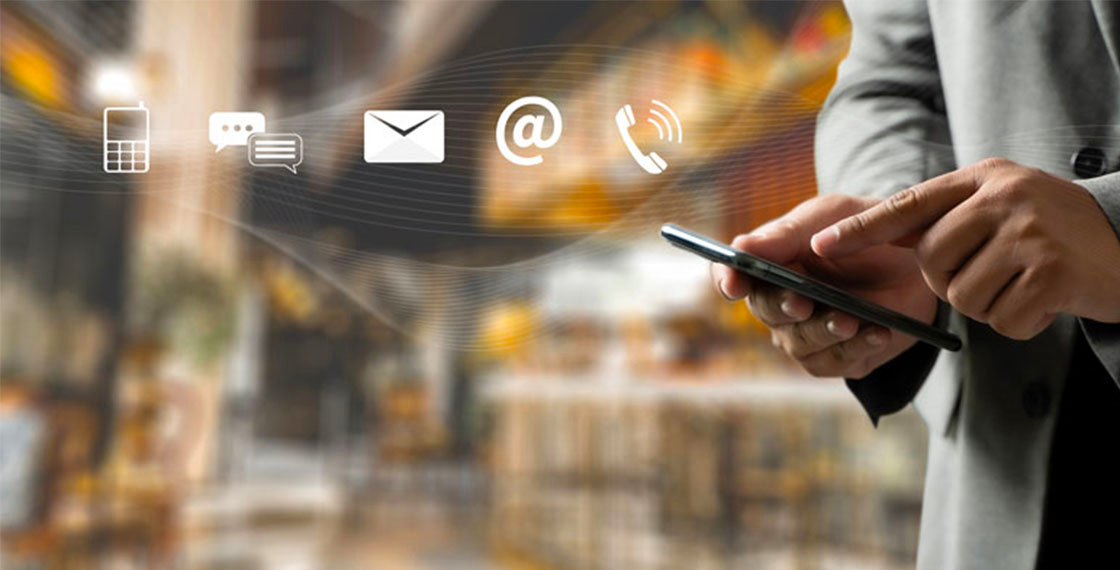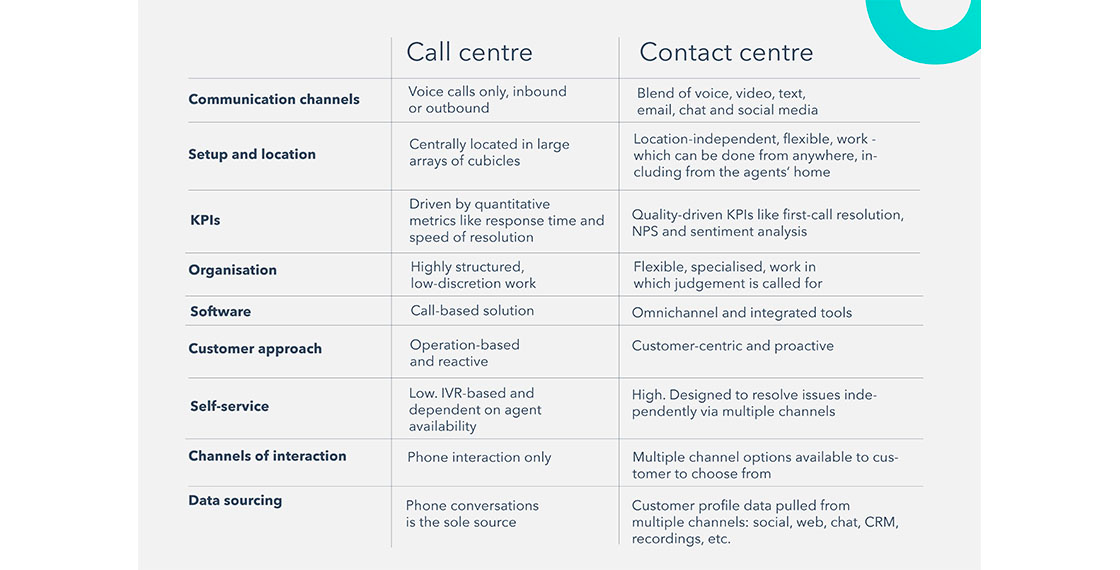Summary
One of my first jobs as a student was working in a call center, we called it the phone farm. It paid better than working in a bar or a shop, it was indoors and sitting down, and I was happy to be working with inbound calls, doing quotes for insurance underwriting instead of cold-calling people to sell them things.Of course this was some time ago, and things have changed. That particular job I once did barely exists any more, because we have automated self-service tools to complete data collection — it’s not worth paying a bored student to ask questions on the phone to punch answers into a screen, when anyone can generate a quote themselves via a simple form on a responsive web app, or increasingly via voice response if they happen to call. Anything routine like that can easily be automated through an IVR, with only exceptional edge cases being routed out to a live human agent and this article will throuw some light on :
Why does the traditional ‘call center’ deserve to be consigned to the history books?

Phone-based customer service provision has actually been through many phases of development since my early experiences, and the place I worked in London later closed down when a trend emerged of outsourcing such work overseas. Educated English speakers in places like India could be hired at a fraction of the cost of even student wages, and in bizarre twists were sometimes told to disguise their location and origin when talking to customers, adopting English names and making topical remarks about sporting events and the weather… Leading to some rather strange heavily-accented conversations which did little to resolve the problem you’d called them about.
Just another cog in the machine
Whether operating in the British midlands or New Delhi, these call centers of the early millennium probably looked and felt quite similar for those working in them. Rows of cubicles, each containing a hardwired terminal and a headset through which incoming calls were steadily routed with zero downtime in between, and a supervisor overseeing large numbers of shift workers via random sampling of live calls. Wages were low, turnover was high — with repetitive and high-pressure work where people got penalised for taking bathroom breaks, sometimes described as ‘white collar factories’. The high staff turnover didn’t matter much to call center managers though, as it was easily-trainable low-skilled work — center agents had little autonomy, followed tight scripts through a series of routed screens, and were actively discouraged from using initiative or personal touches in most circumstances. Next caller coming through!
How have customer expectations changed?

It’s fair to say that back then, the experience frequently wasn’t too great for the customer either, when they needed technical support or to make a complaint about a product or service. Many people will remember the frustration of dealing with an agent unable to exercise the slightest personal discretion, who you knew was working off a script on a screen. It was before the days of robo-process automation, but you might as well have been talking to a robot. You had no way of actually showing them what the problem was, that you were trying to describe, and clearly didn’t fit any of the options they were looking to choose between on the screen they were stuck on. While you tried not to vent your escalating fury at this minimum-wage individual, all you could do was plead to be referred to a more senior manager who might be able to sort out your problem. I remember once being totally thrilled to obtain a direct line to contact someone about 3 tiers up in line at a software company, so I no longer had to spend what felt like hours navigating through the call center hell each time I needed to update on the same ticket.
“Please don’t put me back on hold!”
It wasn’t that long ago — but it feels like a lifetime, in terms of what customers are prepared to put up with. Today our expectations of dealing with businesses are driven by the user experience we enjoy when communicating socially. I might call a friend to talk about something I am thinking of buying, then I text her the link, so she can see which store I am talking about. Here’s a Snapchat of the garment in question — now I have tried it on, so I switch to a video call, so she can give me her opinion on whether it actually suits me. How much does it cost? I send her a scan of the product code, and she quickly searches to see if it’s available cheaper online… Yes, no wonder the high street is rapidly going the extinction route of the cubicle farm, but this is how we communicate with our friends in 2020: Rapidly flicking from one medium, one app, to another, picking up the conversation where we left off, bringing in whatever kind of data we need to best serve our two-way information flow, and maintaining an overview of our whole relationship history in mind whenever and however we’re in touch.So increasingly, we expect the same, when we communicate with businesses and brands.
How does a modern, omni-channel contact center make things better for customers?

Today’s customer service agents aren’t crunching through screens of scripts, or filling in forms on callers’ behalf. All of that is automated away to a combination of IVRs and robo-scripts, meaning that customers can get a quote or file a ticket at any time of the day or night without delay. Instead, human agents are now dealing with complex flows of blended communication, which include a range of data applications like email, IM, images, web form data and even live video and screen sharing. And they’re primarily dealing with the edge cases and exceptions, the enquiries — via any medium — which cannot be addressed by automated services.
Call center vs. contact center: What is the difference?

Delivering the personal touch

They’re using specialist software which integrates with their CRM to quickly contextualise the entire history of a customer interaction: this guy has already had a warranty replacement earlier this year, has now had to email us twice regarding the present complaint, and has been angrily tweeting his dissatisfaction with the brand with increasingly elevated negative sentiment, to his highly influential niche following. He’s been a customer for 4 years and bought multiple units, dispatched as gifts to different addresses, so he really deserves a kid-glove approach, now he’s ended up really unhappy.But that’s alright, because as a professional customer happiness expert, the agent has the discretion to put things right and make everything OK. Perhaps there’s a protocol for this very circumstance embedded in their software, that the natural language voice recognition AI can remind them of just as things start to heat up on the call, or the agent may simply have the authority to issue immediate refund or replace decisions up to a value of X whenever they judge that the brand reputation makes issue makes this the right thing to do.If they’re less experienced or in training, perhaps that augmented listening app can loop in a supervisor who can either intervene in the call, or whisper advice in the background for the agent’s ears only — building their capacity and competence, increasing the number of different scenarios they will deal with confidently in the future.
How does it feel to have a real conversation with a business..?
For the customer, it means that whatever channel they use to contact a brand, it’s part of a continuous conversation.We know that it’s not the same as when we mention something on a friend’s Facebook status and then text them about it later, we know that the business doesn’t have a personal agent who remembers us by name and issue, and is sat there waiting breathlessly for the next update on our faulty gadget (even if the phone system is smart enough to route us to the same person we spoke to last time if they’re free, we appreciate they’re not actually our best friend). Deep down we understand that it’s a smart combination of communications technology which is able to combine and connect our conversations from any direction, and relay them to whomever we next end up talking to, tweeting with, emailing, or screensharing with. But what we appreciate is the joined-up response, which not only resolves our next issue with the maximum speed and elegance, it also shows us that the company we’re dealing with respects our time and attention enough to have invested in advanced customer service software and personnel.
Why we love the illusion, even when we know it’s there...
We’ve always loved personalisation, since the first paper junk mail dropped through our letterbox addressed to us by name instead of ‘dear occupier’.We neither know nor care that email enquiries actually make it easier for the contact center to manage inbound workload across the team more fairly, nor that the agent we’re talking to on live chat actually has 4 different windows open and conversations flowing. We don’t care whether that agent is sitting in a cubicle farm in a big out-of-town industrial estate, working from their own home, or in fact operating from another continent entirely.As a contemporary consumer we spend a quarter of our life’s hours online one way or another, and we simply expect the brands we deal with to be there too, wherever we want to talk to them. It’s a simple enough desire.
Data-driven excellence
With more in-depth and qualitative conversations occurring between agents and customers in the omni-channel contact center, it becomes a central hub for communications. Indeed, in our socially distanced era, increasingly the contact centers is the main public ‘face’ of the business.They’re also the point at which business intelligence meets data analytics, and brands can measure what really matters to their customers, in order to provide continual improvements. In competitive verticals, the service becomes just as important as the product, and satisfaction (or the opposite) with either aspect quickly combines to directly influence our perception of the whole brand.
How do contact centers measure what matters to the customer?
Clumsy, old-fashioned metrics which drove the millennial call centers, such as number of calls dealt with per hour or seconds taken to pick up the call, are giving way to more important ways of measuring what matters — such as first call resolution, how many separate times does a customer have to get in touch, in order to get their issue resolved? How do customers rate the service they receive, in terms of net promoter score, or social media sentiment analysis.Making smart use of the data which your contact center generates, and combining this with data on sales, margins, and performance of specific brand within your business, enables new levels of insight about how to make customers happy — things that would never have been identified by a team of low-skilled phone-answerers ploughing through as many calls per hour as they could. The supervisor of that call center might well have picked up a raised level of calls relating to Product X, which had suddenly developed a problem — but they could only respond reactively to this.
Can contact center analytics fix problems before they happen..?
Looking at customer issues wholistically through the lens of an omnichannel contact center enables brands to generate insights proactively — for example, identifying that the way a customer is using a product could cause them to run into specific difficulties further down the line. With that insight, the customer satisfaction professional can offer unrequested guidance and solutions before they are needed, avoiding problems for the customer they don’t even know about, and pre-empting bad experiences which can have lasting damage to the brand reputation. They can even gather metrics of unexpressed emotion such as ‘rage clicks’ within an app or product, enabling them to reach out to the frustrated user offering assistance, while at the same time collating the evidence of that particular pain-point to escalate for developer attention, so they can fix it even before anyone has complained about it.The shift from the lag indicator of customers complaining to an inbound call center, to predictive insights from detailed data and analytics generated by a multi-channel contact center, helps brands to create those moments of customer delight. They enable a shift up the Gartner Maturity Scale of Customer Service, away from reaction towards true management and orchestration of the customer conversation.The future of customer service is surely the omnichannel contact center, and Ringover is working at the bleeding edge of innovation to bring these tools into their products for customers to use. If your business wants to take advantage of this and grow your customer happiness along with your brand reputation, then now is the time to make the move. The other good news is that even if you are leaning toward a call center environment, setting up a virtual one has never been easier than it is today with the advent of call center software. The benefits of having a call center software in place are unparalleled.
Need to improve customer service in your call center?
Contact our experts to help guide you step-by-step at +44 20 7509 6665 or send an email to sales@ringover.com. Start your free trial today.
Published on June 15, 2020.

